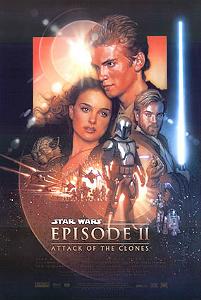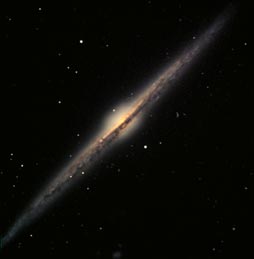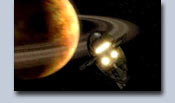
| Bad Astronomy |
|
|
|
BA Blog
|
|
Q & BA
|
|
Bulletin Board
|
| Media |
|
|
|
Bitesize Astronomy
|
|
Bad Astro Store
|
|
Mad Science
|
|
Fun Stuff
|
| Site Info |
|
|
|
Links
|
| RELATED SITES |
| - Universe Today |
| - APOD |
| - The Nine Planets |
| - Mystery Investigators |
| - Slacker Astronomy |
| - Skepticality |
Buy My Stuff

Keep Bad Astronomy close to your heart, and help make me
filthy rich. Hey, it's either this or one of those really
irritating PayPal donation buttons here.
Review: Star Wars: Attack of the Clones

Before the usual Bad/Good stuff, I want to indulge myself for a moment with a personal review of "Attack of the Clones". I liked this movie, for the most part. It had some very weak moments, generally whenever the actors had to actually act. The emotional scenes were fairly wooden, and the dialogue was stilted.
But the overall feel and plotting was really pretty good! Lucas is obviously really laying the groundwork not just for the third movie, but for the first series as well. The devious politicking was complex, but once I saw what was going on the story became pretty cool. Palpatine is playing both sides of fence, encouraging the Federation to secede so that he can rally the Republic against them. He gets absolute power over the Senate, and in the third movie (mark my words) the revolt will be squashed. He can then consolidate the two forces, and his plans will be complete. There will have to be a big scene where Anakin battles Dooku (Christopher Lee's character), gets beat up pretty badly, and becomes Palpatine's right hand man. We'll have to see Yoda and Obi-Wan go into exile as well... and now I think I'll have to watch the original Star Wars too!
So "Clones" is pretty cool stuff. We get lots of gee-whiz action, plus a rather complicated high-level political game too. The special effects, especially in the last hour (the movie runs 2.5 hours) were awesome. I just wish "Phantom Menace" had been this good.
Still, I'll go back and watch PM again now. Lucas was setting things up for "Clones", which I think made that first movie suffer. But if the third one can play off this second one, Lucas will have pulled off a pretty good series of flicks.
If you are still reading this, thanks for letting me wander a bit. I'll note that there wasn't a whole lot of actual astronomy and spacey-type stuff in this movie, but there was some, and of course, some mistakes. So now, on to the astronomy!
Bad (actually, good):
Obi-Wan is trying to find the planet Kamino, which is the
location of the person who
paid an assassin to kill Padme.
He goes to the Republic's
archive, a vast library of information. He cannot find Kamino,
so he asks a librarian for help. He points to a spot on a map of
the galaxy, and says (paraphrasing a bit) "Kamino should be here,
a few parsecs south of the Rishi Maze."
Good:
You're probably thinking that there is no "south" in space, right?
Well, actually, there is! Our own Milky Way Galaxy, and presumably
also the galaxy that existed a long time ago and far, far away,
are both spiral galaxies. This
type of galaxy consists of a large flat disk of stars and gas with
a central spheroidal hub. The disk may have vast spiral arms
sweeping through it, though not all do
(read about spiral galaxies in an article I wrote
for Astronomy Magazine's website). The Sun orbits the center of our own
Galaxy in the disk. To us, in the disk, the galaxy appears as a thin line,
since we are seeing it edge-on (like in the picture shown here,
which is a spiral galaxy much like our own seen edge-on). The
center of the galaxy, toward the hub, appears as a roughly circular
bulge.
 This gives us a natural coordinate system!
We can define the galactic longitude of, say, a star
(or a planet of clones) as its position in the plane of the galaxy,
with the direction to the center of the galaxy defined as
0 degrees longitude. Latitude is then defined as how far above or below
the plane of the galaxy the object is. We pick a direction to be
"above" the plane (since up and down are arbitrary in space)
and call this "north". The other direction is
of course "south". Astronomers actually use a
galactic coordinate system today to map out objects; it's convenient
for many types of observations.
This gives us a natural coordinate system!
We can define the galactic longitude of, say, a star
(or a planet of clones) as its position in the plane of the galaxy,
with the direction to the center of the galaxy defined as
0 degrees longitude. Latitude is then defined as how far above or below
the plane of the galaxy the object is. We pick a direction to be
"above" the plane (since up and down are arbitrary in space)
and call this "north". The other direction is
of course "south". Astronomers actually use a
galactic coordinate system today to map out objects; it's convenient
for many types of observations.
So it's not Bad at all that Obi-Wan says the planet is south of the Rishi Maze. It's actually a perfectly good way to describe it!
Bad:
Someone has tampered with the Republic's archive, removing the planet Kamino,
so Obi-Wan doesn't see it in the
archive's map. However, the gravitational effect of the planet's star
can be seen on the stars around it, which is why Obi-Wan is able to detect
it. As Yoda so poetically put it, "Gravity's silhouette remains".
Good:
Well, again, scientifically this is true. Stars have gravity, and that
gravity does affect all the objects around it. An advanced
civilization, we can assume, could easily detect that effect. My
problem with this is
that the person who removed the system from the map had to have
been very good (and this is even commented in the movie), and yet
they forgot to change the stars around it to compensate! That's
pretty sloppy on the part of the Bad Guy. Can you say
"plot device"? Again, this isn't so much an astronomy error
as it is a way to more easily advance the plot based on someone
else's Bad Astronomy.
Bad:
Obi-Wan chases Jango Fett (Boba's father) to the ringed planet
Geonosis pictured below). They dogfight through the thick rings,
dodging huge tumbling boulders. Trying to kill Obi-Wan, Jango Fett
deploys "seismic charges". When they explode, a huge
shock wave of sound is created, which expands violently outward.
Obi-Wan manages to escape by hiding on the surface of
one of the rocks.
Good:
 We know ringed planets exist, of course; four planets in our own
solar system have them. However, the biggest of the particles in
Saturn's rings, for example, are only a few meters in size. Over
a long time, collisions between the chunks of ice have broken them
up, making them smaller.
Given the number and density of the rocks in the Geonosian rings,
they should have ground themselves to dust a long time before.
Really big rocks, like the one Obi-Wan actually flies his ship
through (and how does an asteroidal body like that get a long
tunnel drilled though it?) shouldn't last very long in such
a system. They're a big target, and the first to get hit.
We know ringed planets exist, of course; four planets in our own
solar system have them. However, the biggest of the particles in
Saturn's rings, for example, are only a few meters in size. Over
a long time, collisions between the chunks of ice have broken them
up, making them smaller.
Given the number and density of the rocks in the Geonosian rings,
they should have ground themselves to dust a long time before.
Really big rocks, like the one Obi-Wan actually flies his ship
through (and how does an asteroidal body like that get a long
tunnel drilled though it?) shouldn't last very long in such
a system. They're a big target, and the first to get hit.
Then there is the matter of the seismic charges. In space, as it is said, no one can hear you scream. Without air, this is literally true: sound needs a medium (like air, water or rock) through which to travel. A vacuum, by definition, is the lack of such a medium, so sound cannot travel in space. I'll accept that movies depict ships making sounds as they move through space, since almost every movie does it, and we, the viewing audience, are used to hearing sounds as things move past us. But I have my limits. The seismic charge, based on sound, cannot work.
Now, I expect Star Wars purists will want to argue this point with me, making claims about how the seismic charges use a subspace blast or some such thing (shades of the Kessel run!). However, I'm not buying it. When the charges explode, we see the flash, but hear nothing for several seconds. Then, BOOM! Since sound travels slower than light, we see the flash immediately, but must wait a few seconds for the sound wave to reach us (which is why we see lightning before we hear thunder). So clearly Lucas is implying that the charges are sonic. In space, that just won't work.
[Note added May 30, 2002: As I expected, the emails have flooded in. There have been many interesting points raised, from the charges vaporizing the asetroids (and so we see the debris expanding) to us just seeing the shock wave itself. Either way, I'm just not buying it! The sound effect accompanying the shock wave is not like that of a blast; it has a more resonant, bell-like quality. Clearly, Lucas was implying something more than just a simple explosion here. And calling it a seismic charge also implies something different than a mine or a missile. So I'm sticking by my guns, haha, and throwing the flag on this one.]
Bad:
While in the rings, Jango Fett is able to
get a few clean blaster shots on Obi-Wan's
ship, making small holes and scorch marks in the hull.
Good:
Scorch marks make sense. However, when
Obi-Wan lands on the planet, we can see the scorch
marks have clearly been blown back, as if by wind.
You can expect that in a dogfight between airplanes, but
spaceships? Again, with no air, there is nothing
to blow against the ship, giving the marks that pattern.
It's possible, barely, that his passage through the atmosphere
as he landed did that, but somehow I think this was
just a physics error on Lucas' part.
[Note added May 30, 2002: I have received quite a few emails about this one. Many people point out, correctly, that if Obi-Wan were accelerating when his ship got hit, then the scorch mark would look like it were blown backwards. Scorch marks are made (I can assume in this case) by vaporized metal from his hull. When it gets heated by the blaster, it expands rapidly. Normally this would leave a circular scorch mark, but if he is accelerating, it would be displaced in the direction opposite the acceleration. So if he is increasing his forward speed, the marks would be behind the actual hole.
However, I'll note that every mark was behind the hole (well, toward the aft, to use ship-lingo). That means that every time he was hit he was accelerating forward. That seems unlikely to me! There have been other explanations emailed to me as well, but like the acceleration idea, they all assume that every time Obi-Wan's ship is hit everything is exactly the same (that is, distance between the ships, their relative angle, speed, etc. is always the same, which they clearly wouldn't be in a dogfight). So again, I'll chalk this one up as an error, pure and simple.]
Bad:
When Count Dooku leaves the planet Geonosis, he uses a solar sail type
ship.
Good:
Solar sails are a theoretical type of spaceship, and
have been used in science fiction for decades. Photons of light
have no mass, but due to the peculiarity of quantum mechanics,
they do have momentum. A solar sail would literally be a huge, lightweight
sail (perhaps made of mylar) that can catch light. It uses the
light from a star as a sort of wind, blowing the sail. A lot
of the physics of solar sailing is like wind sailing on
Earth's oceans!
NASA is actually looking into the engineering
of solar sails. They might very well make a useful method of
moving through interplanetary space. You don't need to carry
much fuel, since the fuel you use is raw sunlight.
However (and here at Bad Astronomy Central there is always a "however"), note that I said interplanetary space. Solar sails accelerate very slowly. It might take weeks or months to get up to a reasonable speed to move between planets. Dooku uses one to travel to another star system. I hope he's not in a hurry! It'll take decades at least to get to another star. Padme mentions that Coruscant is "halfway across the galaxy" from Geonosis, so that journey by sail would actually take thousands or even hundreds of thousands of years. Dooku better pack an in-flight snack.
For more info on solar sails, there is a webpage about the Planetary Society's solar sail project as well.
Conclusions
So, that's it! Like I said above, there wasn't much astronomy in the movie, so there isn't much to comment on. This movie did better than others in the series, and the mistakes weren't that big of a deal; there wasn't much plot that depended on the Bad Astronomy (except maybe the seismic charges).I did enjoy the movie, and plan on seeing it again (after I watch "Phantom Menace" again as a refresher). The first part is a bit slow, and even silly in parts (why oh why does C3P0 get so many lines?), but the last half more than makes up for it. And I can't believe I'm writing this, but I am actually looking forward to Episode 3.
Links
Of course, there are a zillion pages about Star Wars on the web.
- The official Star Wars site is
www.starwars.com. There is a
history of all the movies, lists of planets, aliens, ships
and everything else. If you are a fan, this is the place for you.
- TheForce.net is another
good one, with news and pictures.
- Another detailed site is JediNet.com, with a vast amount of info on all things Star Warsian. It is run by fans, for fans.
|
|
 |